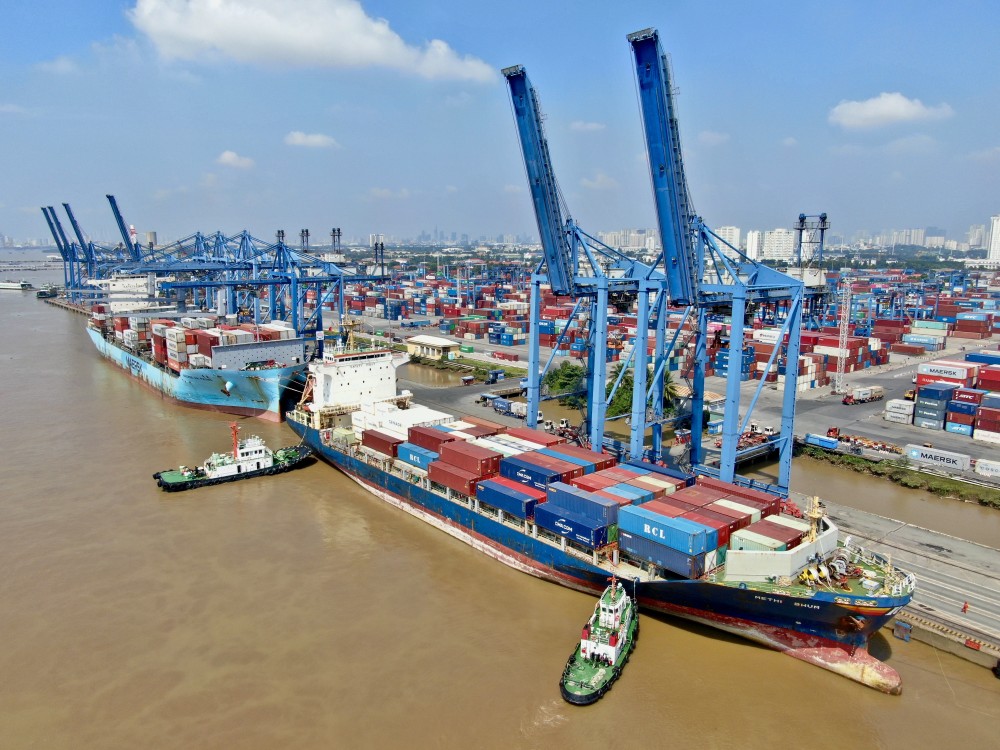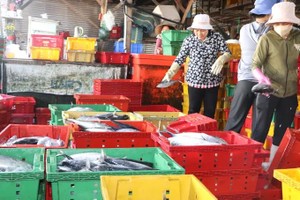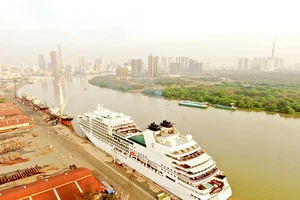
Small businesses hardest hit
According to the freight rate index of Drewry - an independent maritime research consultancy offering market insights and advisory services container, container freight rates began rising rapidly again in early May 2024. Currently, the average rate is over 17 percent higher than in January 2024.
Among these, the freight rates for containerized goods shipped from Asia to Europe and the US have seen the largest increase. Head Nguyen Thi Thuong of the Transport Department under the Vietnam Maritime Administration informed that container sea freight rates are adjusted according to the international market. Vietnam is a link in the global goods supply chain, so Vietnam's freight rates are also influenced by the general price of the world market. Rising sea freight rates are causing many agricultural export businesses to struggle.
Due to the unstable cargo volume at various times, agricultural export businesses often sign short-term contracts, leading to them being impacted when freight rates increase.
General Director Phan Minh Thong of Phuc Sinh Group shared that from April to now, sea freight rates from ports in Ho Chi Minh City to the US and Europe have increased by up to 300 percent compared to the same period, from US$2,950 to US$ 7,350 per 40-feet container and continue to increase. He revealed that his company currently has to pay an additional US$ 5,000 for export to the European and American markets due to selling under the CIF form (seller bears shipping costs). That means if the company exports 100 containers monthly, it has to pay an additional US$ 500,000 (nearly VND13 billion).
Director Hoang Nguyen Hai of Hai An Import-Export Company in Hanoi is concerned that a company intentionally delays orders to avoid losses, which could result in contract penalties or even lost orders. The Vietnam Logistics Service Enterprise Association predicts that transportation prices may continue to rise in the coming time as most shipments from Asia to Europe still detour around the Cape of Good Hope (Africa), extending the journey by an additional 9-14 days to avoid conflicts in the Red Sea.
Worse, container ship fleets anchored offshore near the coasts of Singapore, Malaysia, South Korea, and China are ongoing. In the Americas and Europe, many ports such as Tangier in Morocco and Algeciras in Spain are also overwhelmed unexpectedly, becoming transit points for cargo.
Chairman of Vietnam Ship Agents, Brokers, and Maritime Services Providers Association Pham Quoc Long mentioned that previously, shipping companies quoted rates for 15 days to 1 month, but now they provide weekly quotes, sometimes changing within a day, with increases of 10 percent-15 percent. Many shippers are deeply concerned about the sharp increase in sea freight rates as the peak shipping season approaches.
Responsible agencies work hard to ensure export and import
According to the assessment of the Vietnam Maritime Administration, the volume of import and export-based containerized goods through Vietnamese seaports in the first five months of 2024 reached 7.56 million TEU, an increase of 16 percent compared to the same period. This is the highest growth rate in the past 5 years (3 times higher than the average growth rate of 5.5 percent in the past 5 years). In the face of rising sea freight rates, the Vietnam Maritime Administration has been working directly with container seaport enterprises, shipping lines, and agents.
Director Le Do Muoi of the Vietnam Maritime Administration said that the administration has conducted inspection and supervision teams to monitor service charges at seaports, container sea freight rates, and surcharges as well as assess import and export cargo transportation, and the empty container market in Vietnam.
Based on the inspection result, the administration has proposed many solutions to remove difficulties for businesses, creating favorable conditions to meet all of Vietnam's import and export cargo volume for smooth transportation, said Director Le Do Muoi. The Vietnam Maritime Administration has directed maritime port authorities and sub-departments to closely coordinate with associations, seaport enterprises, sea transport enterprises, import-export enterprises, and relevant agencies in closely monitoring the congestion at ports in addition to the provision of empty containers for import and export goods and regular reports to responsible agencies for timely solutions.
For import-export enterprises, Director Le Do Muoi suggested that industry associations gather member enterprises to jointly build production plans and transportation plans, as a basis for signing long-term contracts with shipping lines, minimizing the maximum impact of freight rates, especially in a period when the market has many complex and unpredictable developments as it is now. The Ministry of Industry and Trade also recommends that businesses consider switching to more favorable and closer export markets such as China, Japan, and ASEAN to reduce the impact of rising freight rates.
























